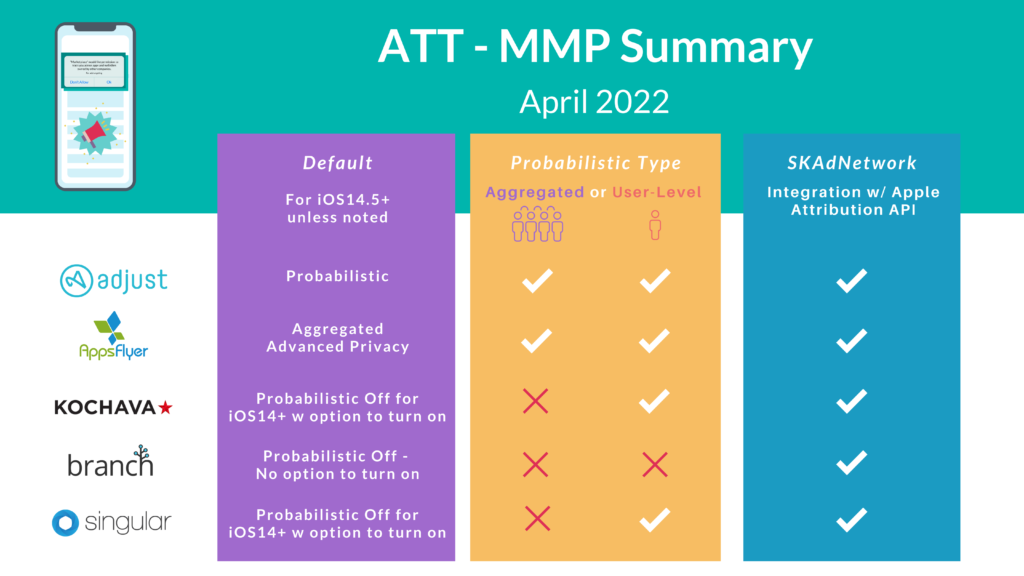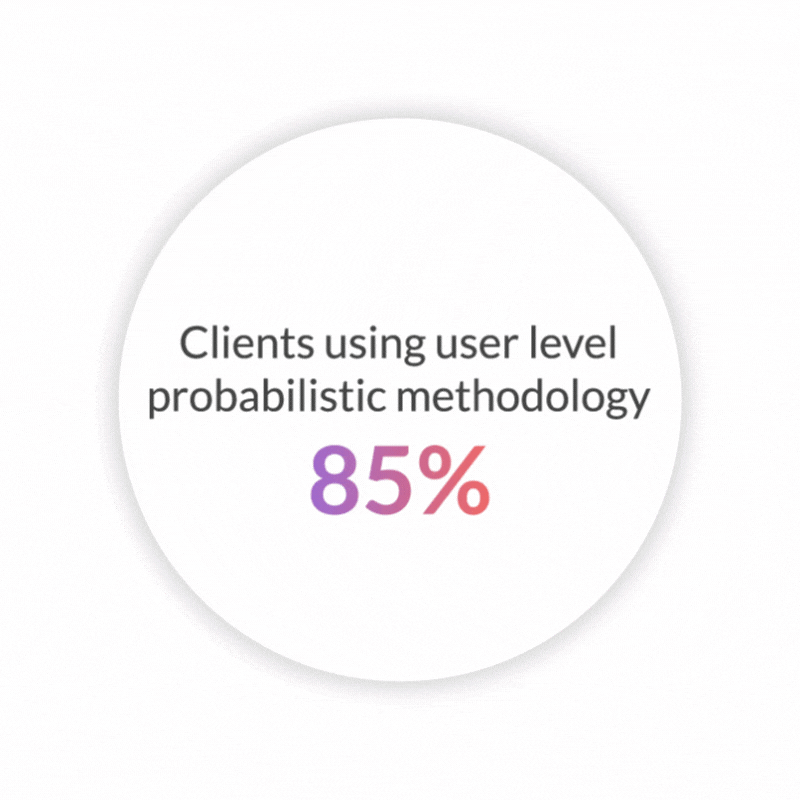Subscribe to our newsletter and get the latest resources sent to your inbox.

What We Learned About ATT and SKAN a Year Later
9 MIN READI don’t have to tell you that the past year has been a whirlwind for mobile marketers. ATT was a huge change. Losing default access to IDFA was expected to impact three main areas: tracking, targeting, and attribution. As expected, without the ability to use a single unique identifier to track users, the ability to target ads and personalize experiences was severely impacted. What was a surprise was the impact (or lack thereof) on attribution.
Initially, when IDFA was deprecated, we were preparing for the potential banning of probabilistic attribution too. Generally, the industry imagined three possible scenarios:
- No probabilistic (SKAdNetwork only) — Some industry leaders believe the spirit of probabilistic matching is against Apple’s privacy-focused intent and it will ultimately be banned by the App Store, making SKAdNetwork the dominant force in iOS attribution.
- Anonymized/aggregated probabilistic — Others, including AppsFlyer, believed aggregated probabilistic modeling (anonymized attribution that hides user identifiers) through MMPs will still be allowed as long as user data is protected. This option mimics SKAdnetwork’s lack of granularity and uses campaign-level data for attribution and partner postbacks.
- Standard user-level probabilistic — Some MMPs have left user-level probabilistic attribution as default, even through the release of ATT. Unlike IDFA, probabilistic device-level predictive attribution requires IP Address and User Agent and other “non-deterministic identifiers” — such as screen brightness, audio volume, locale, language, and timezone — that may be used to help make predictive matches. Click ID/conversion ID are still used.
Apple has so far allowed for the “least change” option (i.e. user-level probabilistic attribution), making no demands on MMPs to use either SKAdNetwork only (most extreme scenario) or, at a minimum, anonymized/aggregated probabilistic attribution. Today, all MMPs we work with allow for user-level probabilistic matching except one. While user-level probabilistic attribution is less precise than IDFA, allowing this type of user-level of attribution has enabled advertisers to continue running iOS traffic more successfully than initially expected. For example, AppsFlyer’s probabilistic modeling boasts “an aggregated accuracy rate of 92% and coverage rate of 89%.”
The importance of adaptability in the face of ATT

We were well-acquainted with probabilistic before ATT. It’s easy to forget that users sometimes had LAT (limit ad tracking) enabled before 2021. Moreover, all mobile web-to-app scenarios also lacked IDFA–it’s no surprise we’re seeing a resurgence in mobile web campaigns.
On FeedMob’s end, we found that ATT gave us unique opportunities to meet the demands of the changing mobile landscape and address our clients’ needs. This will continue to be important, no doubt, as the privacy-first era continues to evolve.
In the first days after ATT went into effect, many MMPs assumed the worst-case scenario — that user-level probabilistic would be disallowed — and prepared for that reality by testing with their new requirements and tools. As it became apparent Apple was not going to disallow probabilistic — at least not right away — we were able to go back to “business as usual” by enabling probabilistic. Here’s a breakdown of the current practices we see across MMPs:

A year after IDFA deprecation, we observe that 85% of our client book is leveraging user-level probabilistic methodology to attribute through their MMP. Other options we’re supporting: more and more clients are testing SKAN, a couple clients are running Android-only campaigns to avoid iOS altogether, and some clients are running aggregated probabilistic campaigns leveraging FeedMob tools such as CID Relay.

- We introduced a Conversion ID Relay tool to mitigate anonymized traffic for supply partners that need at least a conversion ID.
- We implemented SKAdNetwork integration with all MMPs. Early adoption has taught us how to set this up and work with partners (especially DSPs) to integrate their SKAdNetwork with the client’s MMP to further enrich our clients’ iOS data flow.
Perhaps most importantly, we continue to test with SKAdNetwork and user-level probabilistic attribution in a post-IDFA landscape to help assuage clients’ concerns. A year into this adventure, we feel more comfortable than ever, testing strategies that provide the most data granularity allowed by Apple. In fact, the FeedMob team’s focus on supply outside of search and social uniquely positions us to help clients explore new strategies that are less dependent on IDFA — and we’re ready for whatever another year of ATT throws our way.
Posted: April 21, 2022
Category: Mobile Insights Blog, Mobile Performance Strategies
Tags:

